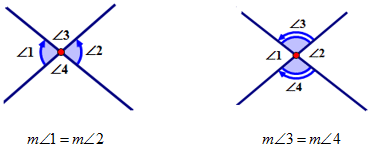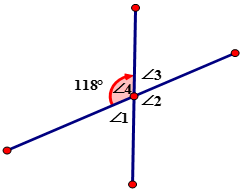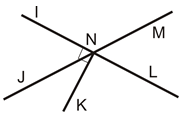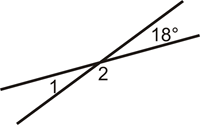6.2 识别相邻和垂直角
章节大纲
-
Susan has taken a keen interest in Geometry and wants to expand her knowledge of angles . While looking through a magazine she saw the following picture:
::Susan对几何学非常感兴趣,想扩大对角度的了解。Susan knew the angles had a relationship but she couldn’t remember what they were called or how she could use the information to figure out the size of the angles.
::Susan知道这些角度有某种关系, 但她不记得这些角度叫什么,How can Susan use the given measures of the angles to find the measure of each angle in degrees?
::Susan如何使用给定角度的量度来找到每个角度的度量?In this concept, you will learn to identify adjacent and .
::在这一概念中,你将学会识别相邻和.。Adjacent and Vertical Angles
::相邻和垂直角When two straight lines intersect each other, four angles are created such that the point of intersection is the vertex for each angle. If two of the angles have a common vertex and share a common side they are called adjacent angles . The adjacent angles formed by two intersecting lines are supplementary which means the sum of their measures is .
::当两条直线相互交错时,将创建四个角度,使交叉点为每个角度的顶点。如果两个角度有一个共同的顶点并有一个共同的侧面,它们就被称为相邻角度。两个交叉线形成的相邻角度是补充性的,这意味着其测量量的总和是180\\\\\\\\\\\\\\\\\\\\\\\\\\\\\\\\\\\\\\\\\\\\\\\\\\\\\\\\\\\\\\\\\\\\\\\\\\\\\\\\\\\\\\\\\\\\\\\\\\\\\\\\\\\\\\\\\\\\\\\\\\\\\\\\\\\\\\\\\\\\\\\\\\\\\\\\\\\\\\\\\\\\\\\\\\\\\\\\\\\\\\\\\\\\\\\\\\\\\\\\\\\\\\\\\\\\\\\\\\\\\\\\\\\\\\\\\\\\\\\\\\\\\\\\\\\\\\\\\\\\\\\\\\\\\\\\\\\\\\\\\\\\\\\\\\\\\\\\\\\\\\\\\\\\\\\\\\\\\\\\\\\\\\\\\\\\\\\\\\\\\\\\\\\\\\\\\\\\\\\\\\\\\\\\\\\\\\\\\\\\\\\\\\\\\\\\\\\\\\\\\\\\\\\\\\\\\\\\\\\\\\\\\\\\\\\\\\\\\\\\\\\\and are adjacent angles. The angles are next to each other, have common vertex and share the common side.
::\\\\\\\\\\\\\\\\\\\\\\\\\\\\\\\\\\\\\\\\\\\\\\\\\\\\\\\\\\\\\\\\\\\\\\\\\\\\\\\\\\\\\\\\\\\\\\\\\\\\\\\\\\\\\\\\\\\\\\\\\\\\\\\\\\\\\\\\\\\\\\\\\\\\\\\\\\\\\\\\\\\\\\\\\\\\\\\\\\\\\\\\\\\\\\\\\\\\\\\\\\\\\\\\\\\\\\\\\\\\\\\\\\\\\\\\\\\\\\\\\\\\\\\\\\\\\\\\\\\\\\\\\\\\\\\\\\\\\\\\\\\180\\\\\\\\\\\\\\\\\\\\\\\\\\\\\\\\\\\\\\\\\\\\\\\\\\\\\\\\\\\\\\\\\\\\\\\\\\\\\\\\\\\\\\\\\\\\\\\\\\\\\\\\\\\\\\\\\\\\\\\\\\\\\\\\\\\\\\\\\\\\\\\\\\\\\\\\\\\\\\\\\\\\\\\\\\\\\\\\\\\\\\\\\\\\\\\\\\\\\\\\\\\\\\\\\\\\\\\\\\\\\\\\\These are not the only adjacent angles formed by the intersection of the lines. The remaining pairs of adjacent angles are shown below:
::这些角度并非线条交叉点形成的唯一相邻角度。 其余的对相邻角度如下所示:When two lines intersect, vertical angles , which are non-adjacent angles are also formed. There are two pairs of vertical angles. These angles also have a common vertex but never share a common side. The vertical angles are opposite each other and are equal in measure.
::当两个线条交叉时, 垂直角度( 即非相邻角度) 也会形成。 有两对垂直角度。 这些角度也有一个共同的顶点, 但从不共享共同的侧面。 垂直角度是相互对立的, 在量上是相等的 。There are two pair of vertical angles:
::有两对垂直角度:and . The .
::1和2;3和4。 m1=m2和m3=m4。Let’s apply all this information about angles to a problem.
::让我们将所有这些关于角度的信息应用到问题上。Using the following diagram , calculate the measures of the remaining three angles.
::使用下图计算其余三个角度的度量。
First, state the relationship between and one other angle.
and are adjacent angles.
::首先,请说明jKL与其他角度之间的关系。jKL和LKN是相邻角度。Next, use this relationship to calculate the measure of .
::下一步,使用此关系来计算 LKN 的度量 。
::@ mJKL+mLKN=180Next, substitute , for the measure of in the equation.
::下面换43 以测量方程式中的jKL
::@ mJKL+mLKN=18043LKN=180Next, subtract from both sides of the equation to solve for .
::下一步,从方程的两侧减去43 以解答 mMKN 。
::-==YTET -伊甸园字幕组=- 翻译组=- 翻译组=- 翻译组=- 翻译组=- 翻译组=- 翻译组=- 翻译组=- 翻译组=- 翻译组=- 翻译组=- 翻译组=- 翻译组=- 翻译组=- 翻译组=- 翻译组=- 翻译组=- 翻译组=- 翻译组=- 翻译组=- 翻译组=- 翻译组=- 翻译组=- 翻译组=- 翻译组=- 翻译组=- 翻译组=- 翻译组=- 翻译组=- 翻译组=- 翻译组=- 翻译组=- 翻译组=- 翻译组=-First, state another relationship between and another angle.
::首先,说明ZQKL和另一个角度之间的另一关系。and are vertical angles.
::@JKL和QMKN是垂直角度。Next, use this relationship to calculate the measure of .
::下一步,使用此关系来计算 QMKN 的度量 。
::@ mjKL=mMKNNext, substitute , for the measure of in the equation.
::下面换43 以测量方程式中的jKL
::@ mjKL=m @MKN43 @mKN @MKN @MKN @MKNFirst, state the relationship between the remaining angle and one other angle.
::首先,说明剩余角与其他角之间的关系。and are vertical angles.
::@LKN和QJKM是垂直角度。Next, use this relationship to calculate the measure of .
::下一步,使用此关系来计算 JKM 的度量 。
::@ mLKN=mJKMNext, substitute , for the measure of in the equation.
::接下来, 替代137, 在方程式中测量 LKN 。
::@ mLKN =mJKM137MQKMExamples
::实例Example 1
::例1Earlier, you were given a problem about Susan and her interest in Geometry.
::早些时候,你得到一个问题 关于苏珊和她对几何的兴趣。She needs to figure out the measure of two equal angles.
::她需要找出两个平等角度的度量The two given angles are opposite each other. These angles are vertical angles.
::给定的两个角度对立。 这些角度是垂直角度 。Susan can use the fact that vertical angles are equal in measure to calculate the measure of these angles.
::Susan可以使用垂直角度等量来计算这些角度的度量。First, write the relation between the two vertical angles such that and .
::首先,写下两个垂直角度之间的关系, 以便% 1 =( 2x- 9) 和% 2 =( x+39) * 。
::m1=m%2Next, substitute the values for each angle into the equation.
::接下来,替换方程式中每个角度的值。
:2x-9) (x+39)
Next, clear the parenthesis by multiplying both sides of the equation by one.
::接下来,通过将方程的两侧乘以一来清除括号。
::2 - 9x+39Next, add 9 to both sides of the equation to group the constants on one side of the equation.
::接下来,在等式的两侧加9,将常数组合在等式的一边。
::2 -9x+392x999999992x=x+48Next, subtract ‘ from both sides of the equation to group the variables on one side of the equation.
::下一步,从方程的两侧减去 'x ' ,将变量组合在方程的一边。
::2x=x+482x-x=x-x+48x=48Use the value of the variable to calculate the measure of and .
::使用变量的值来计算 #% 1 和 # 2 的度量。
::1=(2x-9) 2=(x+39) 1=(2(48-9) 2=(48+39) 1=(96-9) 2=(48+39) 1=(96-9) 2=(48+39) 1=(87) 2=(87) 2=(87)The measures of the two vertical angles are equal.
::两个垂直角度的测量是相等的。Using the following diagram, calculate the measures of the remaining three angles.
::使用下图计算其余三个角度的度量。
First, state the relationship between and one other angle.
::首先,说明4和另一个角度之间的关系。and are vertical angles.
::4和2是垂直角度。Next, use this relationship to calculate the measure of .
::接下来,使用此关系来计算 2 的度量。
::m4=m2Next, substitute , for the measure of in the equation.
::接下来,替换118,以测量方程式中的 4。
::===================================================================================================================================================================================First, state another relationship between and another angle.
::首先,说明4和另一个角度之间的另一关系。and are adjacent angles.
::4和1是相邻角度Next, use this relationship to calculate the measure of .
::下一步,使用此关系来计算 #% 1 的度量。
::m4+m1=180Next, substitute , for the measure of in the equation.
::接下来,替换118,以测量方程式中的 4。
::m4+m1=1801181=180Next, subtract from both sides of the equation to solve for .
::接下来,从方程的两侧减去118 以解答 m1 。
::118 118 1 = 180 118 1 = 118 1 = 62First, state the relationship between the remaining angle and one other angle.
::首先,说明剩余角与其他角之间的关系。and are vertical angles.
::1和3是垂直角度。Next, use this relationship to calculate the measure of .
::接下来,使用此关系来计算 3 的度量 。
::m1=m3Next, substitute , for the measure of in the equation.
::接下来,替换 62 , 以测量方程式中的 1 。
::==========================================================================================================================================================================================Example 2
::例2Using the following diagram, calculate the measures of the remaining three angles.
First, state the relationship between and one other angle.
::使用下图,计算其余三个角度的度量。首先,说明 1 和另一个角度之间的关系。and are vertical angles.
::1和3是垂直角度。Next, use this relationship to calculate the measure of .
::接下来,使用此关系来计算 3 的度量 。
::m1=m3Next, substitute , for the measure of in the equation.
::接下来,换成40 以测量方程式中的11。
::===================================================================================================================================================================================First, state another relationship between and another angle.
::首先,说明1和另一个角度之间的另一关系。and are adjacent angles.
::1和4是相邻角度。Next, use this relationship to calculate the measure of .
::接下来,使用此关系来计算 4 的度量 。
::m1+m4=180Next, substitute , for the measure of in the equation.
::接下来,换成40 以测量方程式中的11。
::m1+m4=180404=180Next, subtract from both sides of the equation to solve for .
::接下来,从方程的两侧减去40 以解答 m 4 。
::{\fn黑体\fs22\bord1\shad0\3aHBE\4aH00\fscx67\fscy66\2cHFFFFFF\3cH808080}4... {\fn黑体\fs22\bord1\shad0\3aHBE\4aH00\fscx67\fscy66\2cHFFFFFF\3cH808080}4... {\fn黑体\fs22\bord1\shad0\3aHBE\4aH00\fscx67\fscy66\2cHFFFFFF\3cH808080}4... {\fn黑体\fs22\bord1\shad0\3aHBE\4aH00\fscx67\fscy66\2cHFFFFFF\3cH808080}4... {\fn黑体\fs22\bord1\shad0\3aHBE\4aH00\fscx67\fscy66\2cHFFFFFF\3cH808080}First, state the relationship between the remaining angle and one other angle.
::首先,说明剩余角与其他角之间的关系。and are vertical angles.
::4和2是垂直角度。Next, use this relationship to calculate the measure of .
::接下来,使用此关系来计算 3 的度量 。
::m4=m2Next, substitute , for the measure of in the equation.
::下一位, 替代 140 , 以测量方程式中的 4 。 m4 = m2140 2 。Review
::回顾Identify whether each angle pair can be classified as adjacent angles or vertical angles or neither.
::确定每个角度对是否可划为相邻角度或垂直角度,或两者兼而有之。1. and
::1. 新加坡和荷兰2. and
::2. INJ和JNK3. and
::3. 扎扎扎纳尼和扎扎纳克4. and
::4. JNL和INM5.
::5. 曼曼德·卡尼勒6. If then .
::6. 如果MINJ=63,那么MMNL。Use this diagram to answer the following questions.
::使用此图表回答下列问题 。7. True or False. and are adjacent angles.
::7. 真实或虚假。% 1 和% 2 是相邻角度 。8. What is the measure of ?
::8. 衡量1的尺度是什么?9. What is the measure of ?
::9.2的衡量标准是什么?10. What is the relationship between and the angle opposite it?
::10. 2与与之相反的角度之间的关系是什么?11. True or False. Adjacent angles 1 and 2 form a straight line with a value of
::11. 真实或假。相邻角度1和2形成一条直线,值180____________________________________________________________________________________________________Answer true or false for each question.
::回答每个问题是否真实或虚假。12. Supplementary angles are also vertical angles.
::12. 补充角度也是垂直角度。13. Vertical angles have the same measure.
::13. 垂直角度的测量尺度相同。14. Adjacent angles always have a sum of .
::14. 近邻角度总有180个。15. Adjacent angles are also vertical angles.
::15. 近角也是垂直角。16. Vertical angles are formed when lines intersect.
::16. 当线条交叉时形成垂直角度。Review (Answers)
::回顾(答复)Click to see the answer key or go to the Table of Contents and click on the Answer Key under the 'Other Versions' option.
::单击可查看答题键, 或转到目录中, 单击“ 其他版本” 选项下的答题键 。










